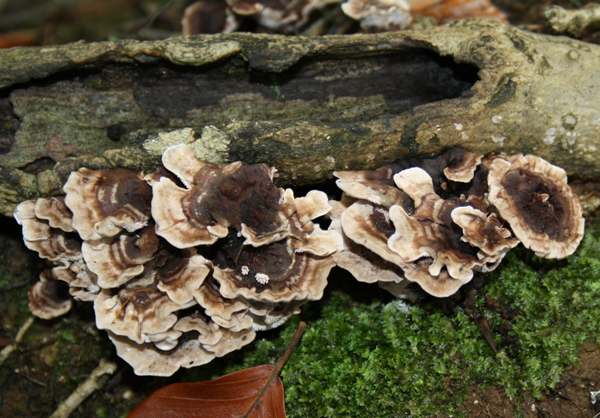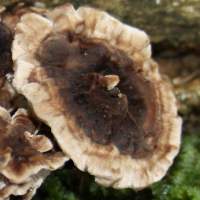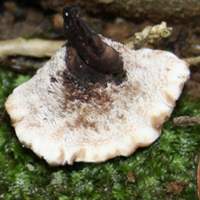Phellodon melaleucus (Sw. ex Fr.) P. Karst. - Grey Tooth
Phylum: Basidiomycota - Class: Agaricomycetes - Order: Thelephorales - Family: Bankeraceae
Distribution - Taxonomic History - Etymology - Identification - Culinary Notes - Reference Sources

This tough hydnoid (toothed) fungus is known as Grey Tooth; however, especially when young the readily visible parts of these fungi are not always particularly grey and they are never entirely grey. (In many instances Brown Tooth would not be an inappropriate name!) Fruitbodies usually appear in small groups so that several caps become fused together.
Distribution
Phellodon melaleucus is a rare find in Britain (where most confirmed records are from the Caledonial Forest, northern Scotland, and very rare in Ireland, but it is a more frequent sight in some parts of southern Europe. This species is also recorded in North America.
Taxonomic history
In 1815 the great Swedish mycologist Elias Magnus Fries described this species, sanctioning work by Swedish botanist Olof Peter Swartz (1760 - 1818). Fries gave Grey Tooth the scientific name Hydnum melaleucum. In 1879 Finnish mycologist Petter Adolf Karsten (1834 - 1917) transferred the Grey Tooth fungus to the genus Phellodon, renaming it as Phellodon melaleucus.
Common synonyms of Phellodon melaleucus include Hydnum melaleucum Sw. ex Fr., Hydnellum melaleucus (Sw. ex Fr.) P. Karst., Phellodon graveolens (Pers.) P. Karst., Hydnum albonigrum Peck, and Phellodon alboniger (Peck) Banker.
Etymology
The genus Phellodon was circumscribed by Finnish mycologist Petter Karsten; the generic name comes from phell- meaning cork, and -don meaning tooth. These are indeed tough, cork-like tooth fungi. The specific epithet melaleucus means black and white.
Identification guide
 |
CapFlat topped or occasionally with a shallow depression, the faintly radially-zoned upper surface is initially velvetty and eventually develops radial wrinkles. The cap surface is grey-brown with a much paler marginal region. Usually ranging from 2 to 6cm across, larger specimens tend to have lobed and wavy margins. The fibrous flesh is zoned in shades of brown to reddish-brown; it turns green with KOH. |
 |
SpinesThe lower (fertile) surface of this hydnoid fungus is covered in white spines that gradually turn brown with age. Spines are up to 3mm long and decurrent to the stem. Stem1 - 1.5cm long and 1 - 0 5mm in diameter, the stem is more or less cylindrical, blackish brown and smooth to finely fibrillose; several stems are sometimes fused at the base. |
SporesEllipsoidal to subglobose, spiny, 3.5-4.5 x 3-4μm (excluding spines, which are up to 0.5um tall), hyaline, inamyloid. Spore printWhite. |
|
Odour/taste |
Odour slightly spicy when old; taste mild or slightly bitter. |
Habitat & Ecological role |
Mycorrhizal, in coniferous and broadleaf woodlands, very often under oaks, Beech and Sweet Chestnut in southern England but also found with pine (especially in central and southern mainland Europe), spruce and Douglas Fir; usually on acidic sandy soils. Also recorded on acidic heathland with Bilberry. |
Season |
August to November in Britain and Ireland. |
Similar species |
Several other members of the Phellodon genus occur in similar habitats. |
Culinary Notes
Phellodon melaleucus is a tough inedible fungus. It is unclear whether Grey Tooth contains toxins, and we know of no recipes for this rather uncommon tooth fungus.
Reference Sources
Fascinated by Fungi, 2nd Edition, Pat O'Reilly 2016, reprinted by Coch-y-bonddu Books in 2022.
British Mycological Society (2010). English Names for Fungi
Dictionary of the Fungi; Paul M. Kirk, Paul F. Cannon, David W. Minter and J. A. Stalpers; CABI, 2008
Taxonomic history and synonym information on these pages is drawn from many sources but in particular from the British Mycological Society's GB Checklist of Fungi.
Fascinated by Fungi. Back by popular demand, Pat O'Reilly's best-selling 450-page hardback book is available now. The latest second edition was republished with a sparkling new cover design in September 2022 by Coch-y-Bonddu Books. Full details and copies are available from the publisher's online bookshop...

